One day, the Internet may at last rest its case against George Lucas and his incessant tinkering, but I hope that day does not come any time soon. The relationship between artist and audience is not a simple one, no matter how much the MPAAs, RIAAs, and SOPA-supporting politicians of the world wish to legislate it into being so, ((Their view: the artist makes and the audience buys, and the audience’s part is over before the ink dries on the receipt tape.)) and the Affair Lucas affords us all the chance to wrestle ((My vote for the best wrestling goes to the Red Letter Media guys. You’ve probably seen their famously long prequel reviews, but you might not have caught their recent two-part feature on The People Vs. George Lucas (part of the highly underrated Half in the Bag movie review series), which manages to find even more to say about the Lucas and the holy trilogy without retreading much at all from before. Absolutely worth the look.)) with all the messy and complicated strands of thought knotted up in the nagging feeling that it’s just Wrong for one man to have so much control over something that matters so much to so many but which he clearly no longer understands. ((The Red Letter guys make a pretty good case that he never understood it to begin with in that link above that you’ve already watched, right? Right?! Oh, you were waiting until I actually got to the funny pictures before leaving the site? That’s cool, too.))
While I’d certainly like to join the Lucasian fray, the subject of this here blog is the Middle Ages, so instead I’ll have to content myself with pointing out that Lucas is not the first person to let things get out of hand when touching up a pre-existing work of art. To this point I humbly enter into evidence a manuscript I’ve featured here quite a bit, the British Library’s Royal MS 10 E iv, also known as the Smithfield Decretals, a late fourteenth-century law book containing many illuminations including, but not limited to: a fish-slapping fight fought for the love of a naked mermaid, the constant threat of surprise bear attack, a hunting dog’s day in rabbit court, and bloodthirsty maidens who will not be wooed, thank you very much. And so that you don’t stop reading this post on account of excessive peremptory framing and explanation, here’s a bonus image that the British Library’s online catalog files under the innocuous heading ‘woman attending to a man seated by the fire’:
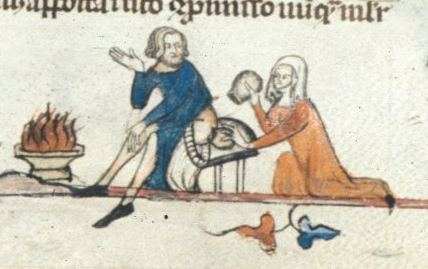
For once, however, marginal butts and things coming out of them are not enough for me to make a post out of, but it’s a good image to begin with nevertheless, as it (as well as all the other weird things I’ve posted about over the years) seems to have been a part of the original plan of the manuscript, the Original Theatrical Version, if you will. You might wonder what sort of person asks to have their law textbook decked out with things like that, and this time I can give an almost definitive answer. The book was likely first commissioned by John Batayle, one of the younger sons of an aristocratic family from Essex who ((As lots of younger sons ended up doing on account of the whole ‘the eldest son inherits everything and you lot are out of luck’ principle that medieval property law was built on.)) went on to become an Augustinian canon. Before settling down to the monastic life, it seems he spent some time in the south of France, possibly studying law, since his law book was written in a hand usually found there. ((I should note that when he first had it made, the book was undecorated but with spaces left for decorations to be added later once he got back to Smithfield. So the big cycle of illuminations might correspond more closely to the 1997 Special Editions. Look, you come here for the funny pictures. Precision in analogy is an occasional bonus.))
At first, Batayle went for the fancy stuff–gold leaf, intricate full column illuminations, and his family’s coat of arms all over the place, all done by a highly skilled illuminator–but he didn’t have the money to do the whole book that way, so he had to get by with only decorating the first handful of pages. Sometime later he decided to spend some money again, but went for quantity over quality, hiring a less technically skilled artist to illuminate almost every remaining page with either decorative borders or elaborate bottom-of-the-page illustrations, and often both. It’s unlikely he dictated to the architect of this manuscript revision exactly what should appear on each page, perhaps insisting on a couple of themes or stories he’d like to see, ((BATAYLE: I like giants, monkeys, bears, hunting, chicks, St. Mary, the other St. Mary, Guy of Warwick, Reynard, boats, um… giants, uh…–you know, cool awesome stuff, stuff that rules, and yeah, pious stuff so I can show it off to mom. ARCHITECT: Oh, I think we can do something very nice along those lines, never you worry, m’lord, should I just bill your father?)) but whoever ultimately got the contract made up for his lack of technical proficiency with crazy ambition. Under this illuminator’s brush, the bottom of the pages became something like a pictorial Canterbury Tales (minus the pilgrims), an elaborate chain of stories that circle back on the same themes, with a rotating cast that takes on different roles from story to story. At one moment it’s bloody, then at the next bawdy, then pious, then piously bawdy, then bawdily bloody, and sometimes bawdibloodipiousybawdish.
Yet for whatever reason, John Batayle (or someone who owned the book not long after him) still wasn’t happy. Yes, the stories were interesting and weird, but were they really weird enough? Apparently not, for yet another illuminator was called in to touch up the pages. A Special Edition was needed. And like that certain notorious science fiction director in his old age, this new illuminator couldn’t stand looking at white space, and he filled it in much the same way: with a bunch of strange creatures that have little to do with the story that’s being told in the foreground. For example, the last time I talked about the hound-hanging rabbits, I cropped the image so that only the main story was visible. Without my cropping, you end up with this:
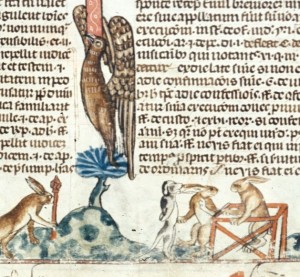
While the rabbits try their captured hound, a giant bird is just cold chillin’ there in the tree. The rabbits have no idea he’s there, of course, because he wasn’t there when they were drawn. The bird doesn’t add anything to the scene (except for a giant bird); he’s just kind of there for the sake of being there, but in being there he draws our attention away from the first illuminator’s work. And this kind of thing happens on almost every page. I don’t, for instance, know what these three kings were originally discussing:
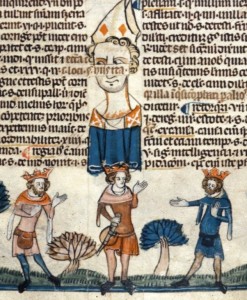
But now it’s pretty clear they’re having a casual chat about the gigantic floating bodiless bishop head that has made its roost in the middle king’s crown.
And it’s hard to notice how the devil is cheating in this traditional image of an angel weighing a sinner’s soul to determine its place in the afterlife…
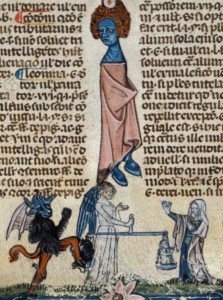
…what with the giant blue guy balancing there atop the angel’s head. (If I didn’t know better, I’d suspect the devil put him up to it.)
And sometimes, the second illuminator seems to actually go out of his way to ruin what the original did. Why else would he add a bird projectile vomitting to a fairly important scene in the middle of The Adventures of This Amazing Knight Who Was Raised By Lions? ((Title surmised then shortened from the more probable The Adventures of This Amazing Knight Who Was Raised By Lions No Not That One The Other One Who Was Just As Amazing.))
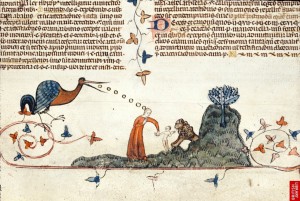
Why else this giant bird poised to snap off the head of this woman found in a Lockhornish series of images of marital strife?
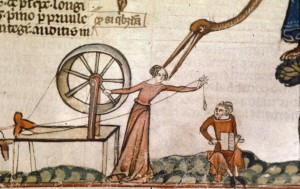
Yes, she’s going to hit the guy over the head later with that wool carding thing he has there, and yes that joke was old even then, and… well, actually, come to think of it, The Lockhorns would work a lot better with giant birds always moments away from devouring Loretta. ((Also, did you guys know the lady’s name was Loretta?–by which I mean to say, aren’t I clever for knowing the name of the lady from this legacy strip no one has ever cared about ever? I almost certainly did not obtain this information from Wikipedia in order to make the reference.)) Carry on, gigantic bird, carry on.
Obviously, my George Lucas analogy got lost somewhere there in the flock of giant birds, and I’ll even admit it’s not particularly apt. I mean, yes, the weird things that detract from the cleverness of the earlier version were added by a later hack who seems to have hated and misunderstood the original, but that hack’s work was limited only to a single person’s copy, and he was probably working under the owner’s direct orders. It’s not like he had the legal power to make sure that all subsequent editions of Gregory the Great’s Decretals apart from this one copy in Smithfield also had to feature giant birds and floating bishop heads whether Gregory’s fans wanted them there or not.